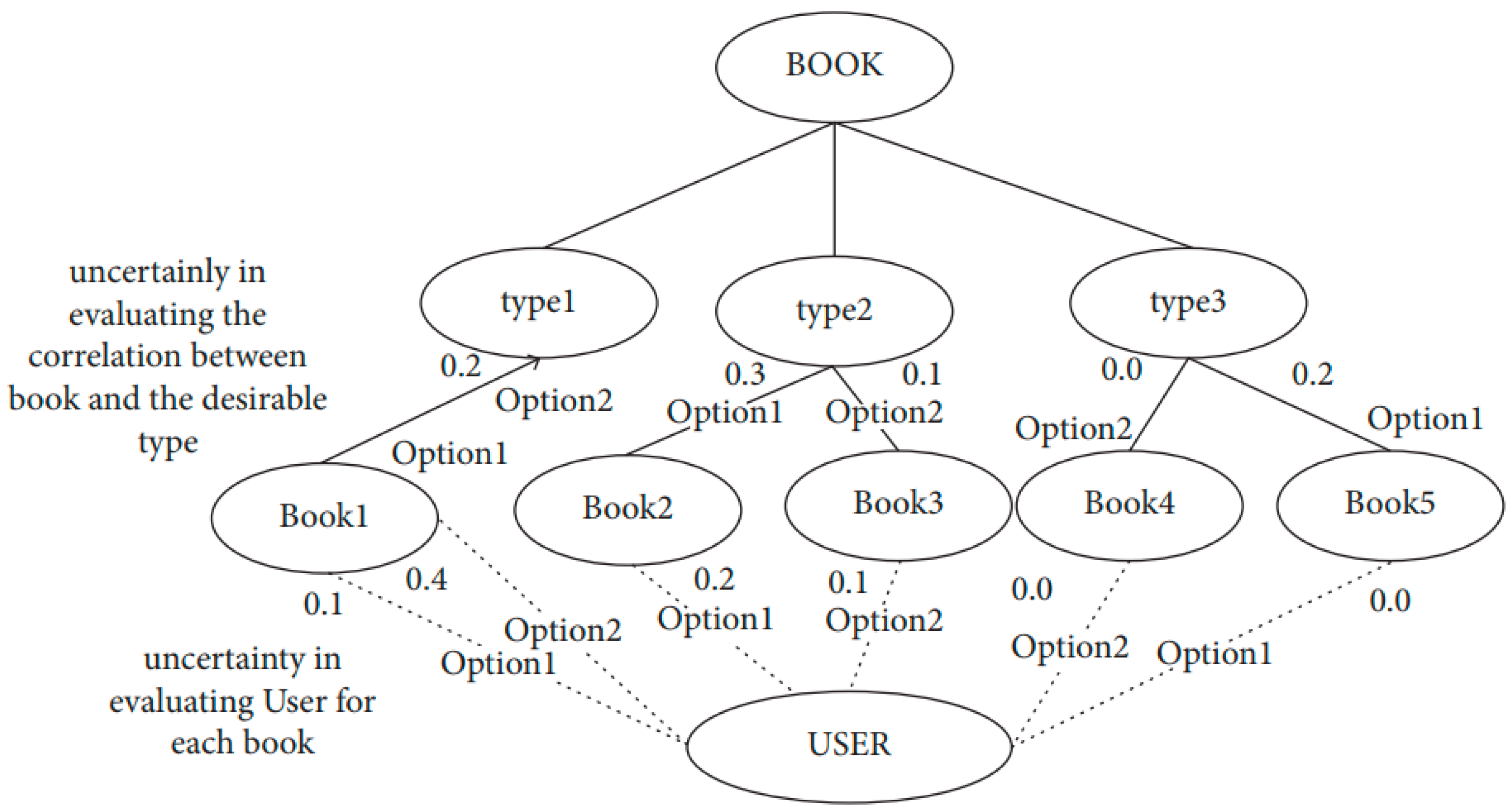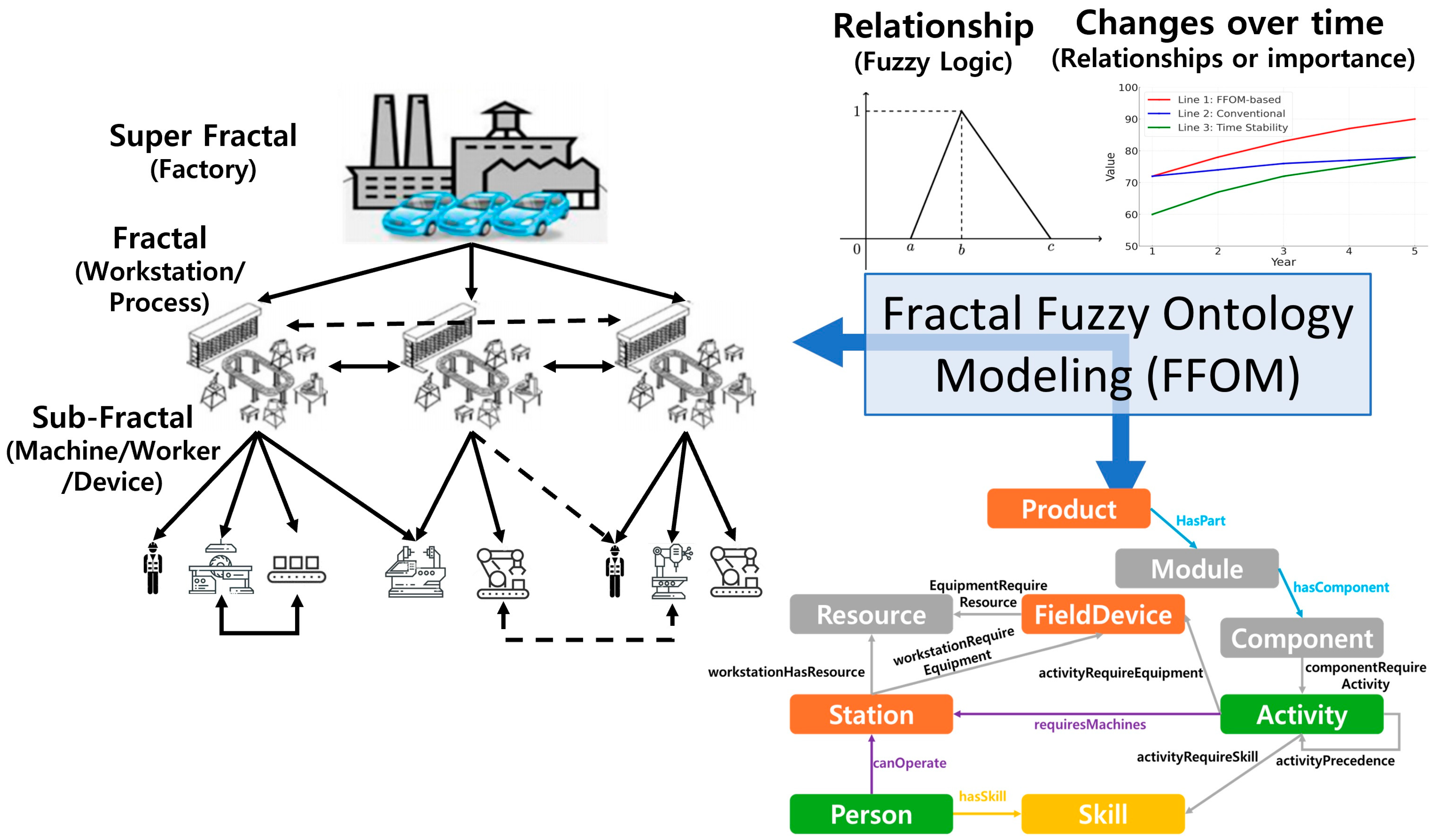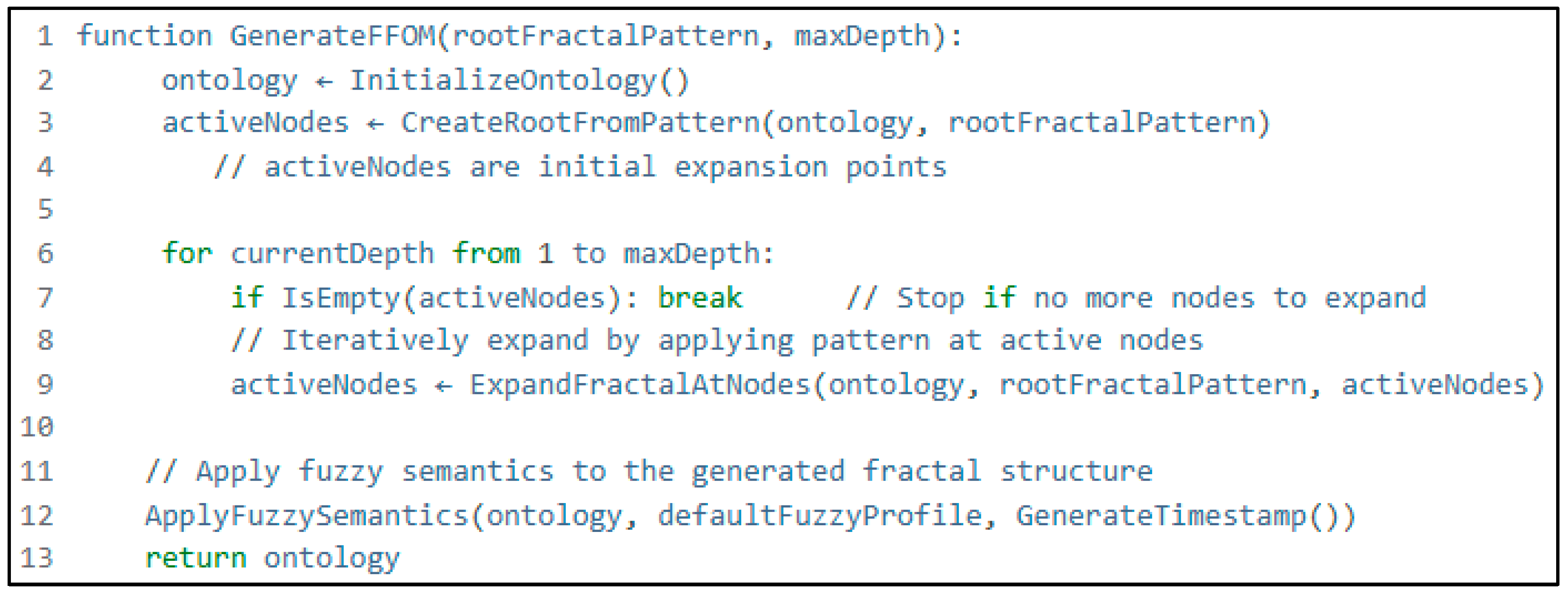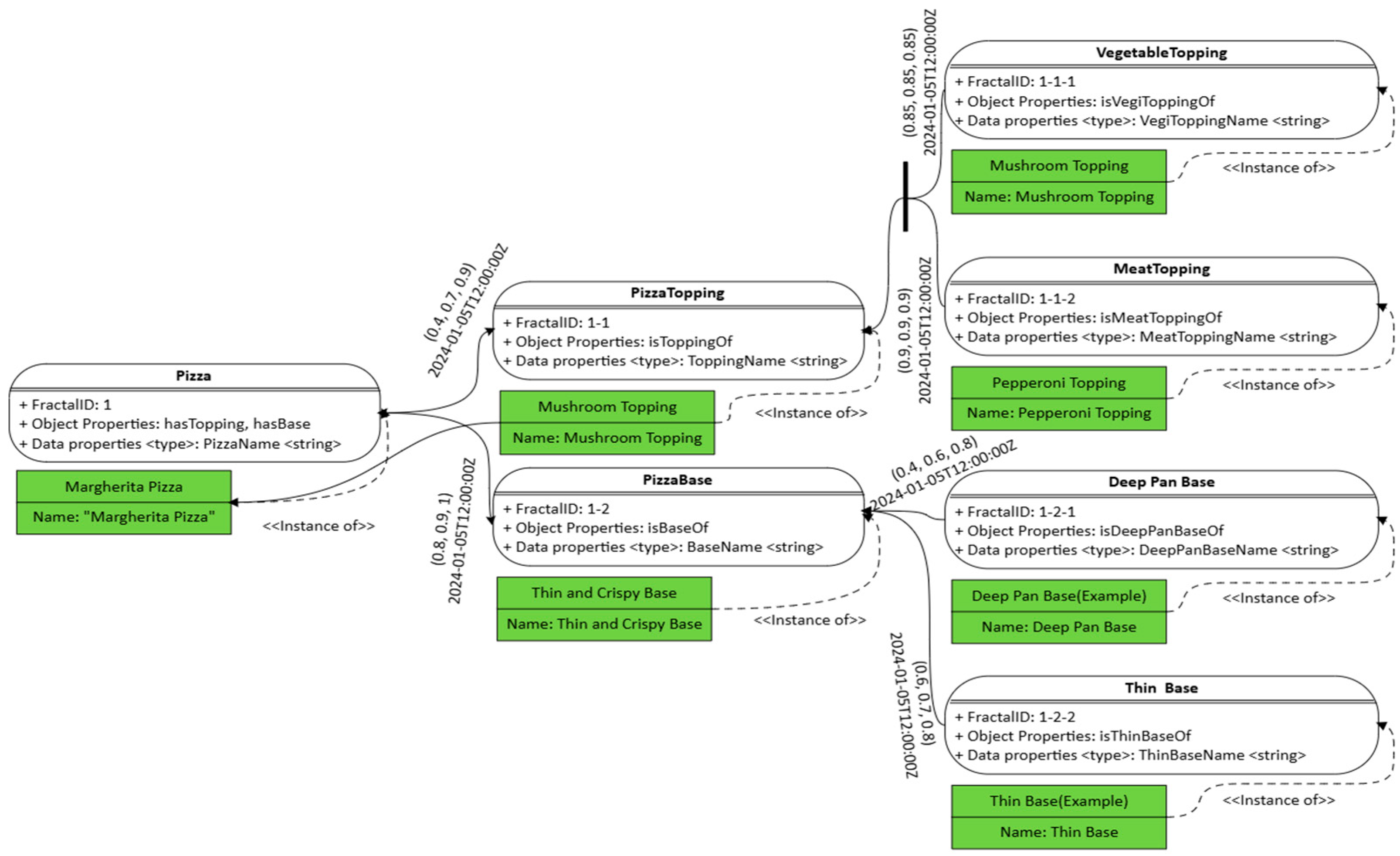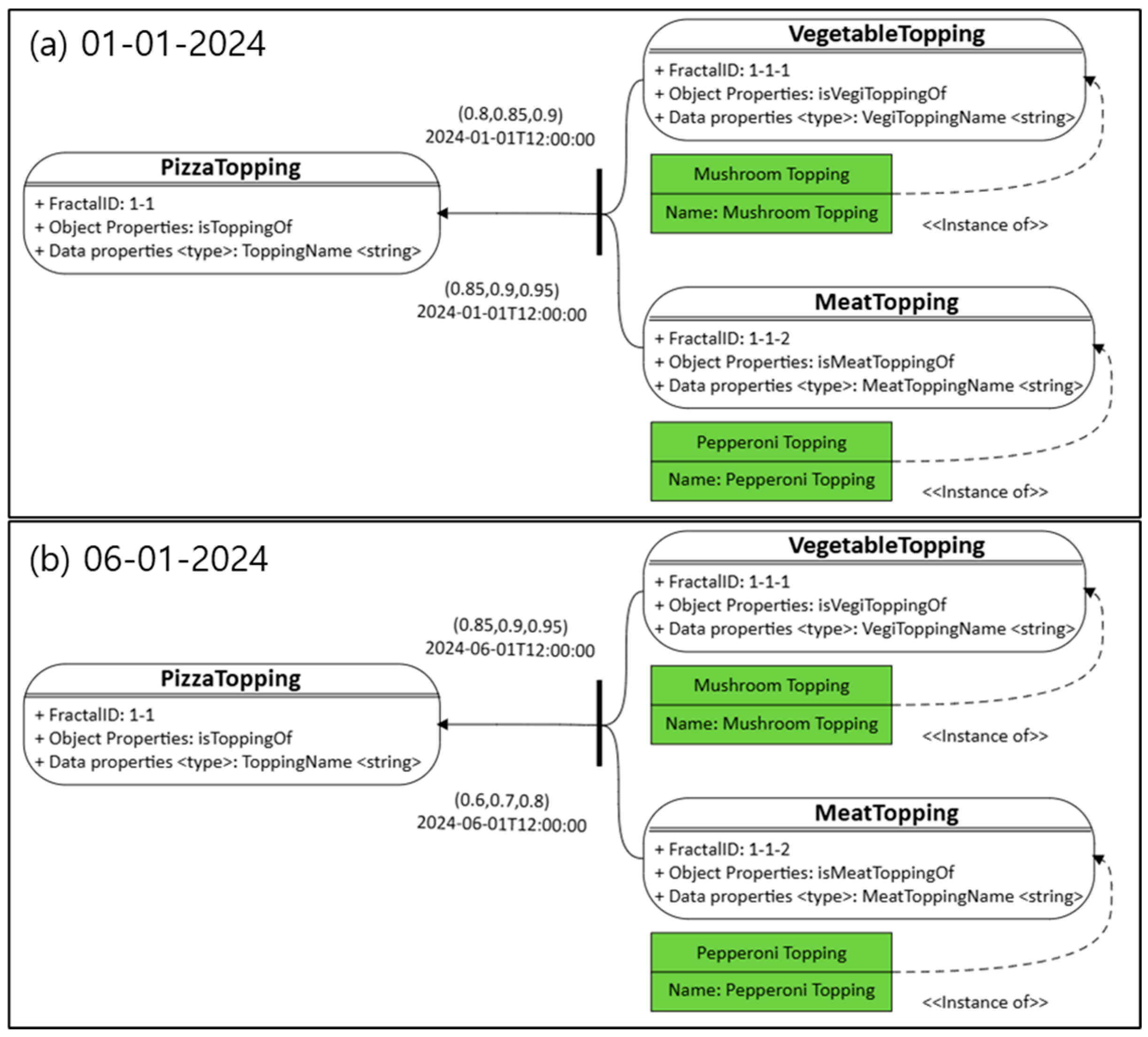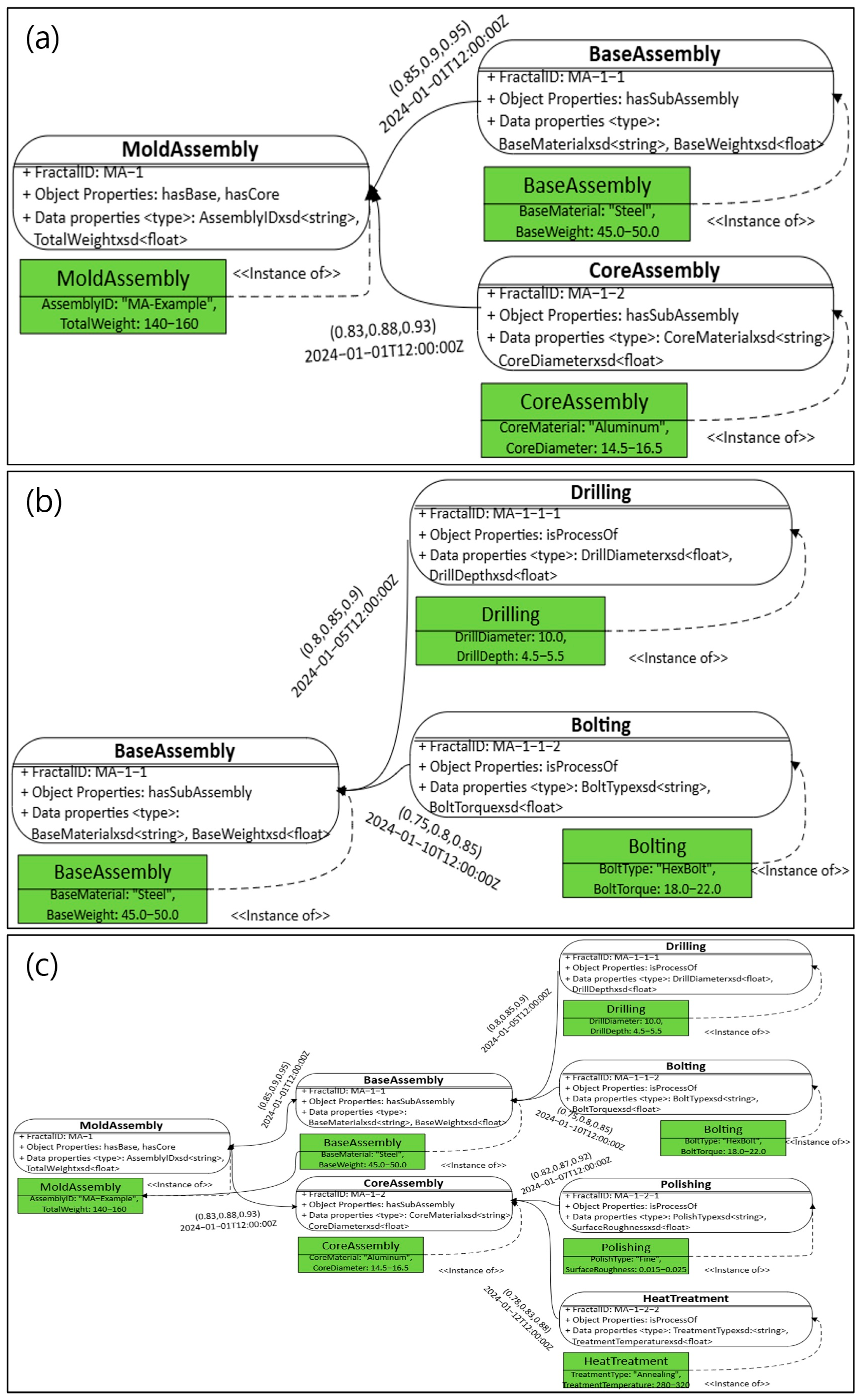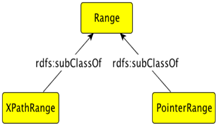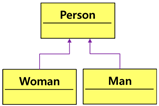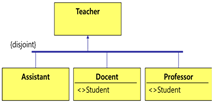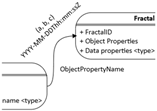3.1. Necessity of FFOM
FFOM is explicitly designed to enable agile and dynamic ontology evolution. By leveraging self-similar fractal patterns, it supports modular updates, without reengineering the overall structure. Fuzzy logic ensures that shifting process conditions and ambiguous real-world signals can be continuously reflected in the ontology. Thus, FFOM operationalizes adaptability in regard to both the structure and semantics.
The fundamental concept of FFOM is inherently agile hierarchical data modeling, implemented through the application of fractal structures. Fractal structures, characterized by self-similarity, facilitate the construction of repetitive patterns commonly encountered in manufacturing environments, such as assembly and processing. They are not simply static representations. The fractal approach provides structural agility. New process steps, such as quality control, robotic handling, or entire sub-layers, can be seamlessly integrated as new instances of the defined fractal patterns, with minimal modifications to the overall ontology. This is in sharp contrast to traditional models that require significant restructuring, which is prone to errors due to this additional work. The fractal nature of FFOM, therefore, directly supports dynamic scalability and adaptability, allowing the ontology to evolve naturally with the manufacturing system it represents, ensuring its continued relevance and accuracy.
FFOM complements structural agility by incorporating fuzzy logic to provide semantic agility in regard to managing data uncertainty and ambiguity. In dynamic manufacturing environments, many critical variables, such as machine efficiency, material properties, and process tolerances, are inherently imprecise or change over time. Traditional binary logic struggles with this reality. FFOM leverages fuzzy membership functions and timestamped fuzzy values to model these variables and their relationships as ranges or distributions that can be updated in real time. That is, ontology can dynamically reflect the current state of uncertain parameters without changing the underlying classes or properties, enabling more realistic and context-sensitive reasoning and agile decision making, based on up-to-date but imprecise information. This semantic flexibility ensures that ontology continuously responds to real-world dynamics.
The necessity of FFOM arises from the increasing complexity and dynamic nature of modern manufacturing operations, where real-time data analysis and decision support are critical. Traditional static and rigid ontology models fail to meet these demands, due to limitations in terms of scalability and their inability to accommodate uncertainty. FFOM addresses these challenges by introducing a scalable and adaptable data management paradigm that aligns with the intricacy and variability of manufacturing processes.
Figure 2 provides an expanded conceptual overview of FFOM, demonstrating how fractal structures achieve hierarchical scalability and how fuzzy logic handles uncertainties across various industrial scenarios. The diagram also emphasizes the role of OWL-based ontology for standardizing data representation and ensuring interoperability among diverse systems, enabling legacy platforms and new modules to communicate seamlessly. As a result, FFOM’s adaptive framework is unparalleled in its ability to support large-scale, dynamic processes, continuously evolving with data-driven insights. This paves the way for more intelligent and efficient industrial operations.
FFOM enhances automated reasoning and decision support by integrating fuzzy inference mechanisms, which provide intelligent recommendations based on uncertain data. It also incorporates temporal representation and historical data integration, enabling adaptive learning and trend analysis by tracking data changes over time. FFOM supports efficient querying and data retrieval through semantic reasoning, ensuring that industrial applications can extract meaningful insights for optimized decision making. FFOM is expected to be able to integrate these capabilities into a powerful and flexible ontology framework that can solve complex challenges in modern industrial environments.
This section details the FFOM methodology. It begins by providing a formal definition and outlining the foundational concepts of the framework. It then explains the principles of fractal-based structural design and concludes with details on the systematic process for transforming the conceptual FFOM model into a standard OWL implementation for practical use.
3.2. Foundational Concepts and Formal Definition
To address the increasing need for an adaptive and semantically enriched ontology framework capable of handling the complexities of dynamic industrial environments, FFOM is formally defined as a graphical and conceptual ontology modeling methodology. It is designed to represent rich and complex knowledge involving hierarchical structures, uncertain data, and evolving relationships by distinctively integrating key principles from fractal geometry, as explained in
Section 2.3, and fuzzy set theory, as described in
Section 2.4. FFOM provides a structured yet flexible approach for designing, managing, and evolving ontologies, specifically tailored for complex and dynamically changing domains.
The primary characteristic of FFOM is its synergistic combination of a fractal structural layer with a fuzzy semantic layer, supported by a graphical notation and an OWL transformation pathway. The fractal structural layer employs fractal pattern templates and principles of recursive instantiation to construct ontology structures that are inherently scalable, modular, and adaptable to change, with minimal redesign effort. This facilitates the systematic organization of complex, hierarchical information, often found in the manufacturing industry. Complementing this, the fuzzy semantic layer incorporates fuzzy logic to systematically manage vagueness, ambiguity, and imprecision. This is achieved through the explicit representation of fuzzy data, primarily using TFNs for attributes and relational strengths, alongside mechanisms for their defuzzification into crisp values, where needed, for practical application. FFOM also conceptually supports the use of linguistic variables for richer semantic expression and allows for the application of fuzzy operators and IF–THEN rules to enable nuanced reasoning under uncertainty, typically operationalized via external reasoning engines that constitute the FFOM–OWL model. The FFOM framework utilizes a set of graphical primitives, described in
Table 3, for its visual construction, which are extended to accommodate fuzzy and temporal annotations. Finally, a defined OWL transformation pathway, detailed in
Section 3.4, ensures that FFOM conceptual models can be formally represented in a standard, machine-interpretable, and interoperable format, leveraging existing semantic web tools and infrastructure. FFOM is thus proposed as an integrated and formalized approach to ontology engineering, offering enhanced capabilities for domains requiring both structural adaptability and robust uncertainty tolerance.
Complementing this fractal structural layer, the fuzzy semantic layer in FFOM introduces fuzzy logic to represent and reason about inherent vagueness, ambiguity, and uncertainty. For fuzzy value representation and defining the data type structure, FFOM primarily employs TFNs for representing a relational strength between fractals. A TFN is formally represented as an ordered triple (a, b, c), where a, b, c are real numbers in the interval [0, 1] satisfying a ≤ b ≤ c, denoting the lower bound, modal value, and upper bound, respectively. The encoding of these TFNs into the conceptual model is typically guided by domain expert knowledge or derived from empirical data. The decoding or defuzzification of the TFN into a single crisp value, which is essential for practical applications, such as deriving an assembly confidence score, is carried out using a centroid-based method that places greater weight on the modal value. For example, the result of a centroid calculation, i.e., (a + 2b + c)/4, can serve as its representative crisp output. This formulation reflects the central tendency more effectively by emphasizing the modal value, resulting in a more representative and context-sensitive crisp output. FFOM also conceptually supports linguistic fuzzy modifiers, such as ‘very’ or ‘slightly’, whose application typically involves transforming the membership function of the base fuzzy set they modify, for instance, by concentrating the membership degrees for ‘very’. Furthermore, to determine the strength of derived or composed relationships where intermediate links are expressed as TFNs, FFOM accommodates the use of fuzzy operators. A common method for such relational composition is fuzzy multiplication, often applying the product t-norm component wise to the TFNs. For example, if TFN
A→B = (a
1, b
1, c
1), which means that the TFN values from fractal A to B are a
1, b
1, and c
1, and TFN
B→C = (a
2, b
2, c
2), then the composed TFN
A→C can be approximated as (a
1·a
2, b
1·b
2, c
1·c
2). The execution of complex fuzzy IF–THEN rules, the operationalization of fuzzy modifiers, and the computation using fuzzy operators are generally managed by external fuzzy reasoning engines or specialized application logic, for which FFOM’s OWL representation provides the structured fuzzy data input. To ensure compatibility with existing semantic web technologies, FFOM also defines an OWL transformation pathway. This consists of a clear methodology and dedicated mapping strategies to translate both its fractal structural and fuzzy semantic layers into OWL 2, the Web Ontology Language standard. Through this transformation, detailed in
Section 3.4, the full semantic richness and flexibility of FFOM can be formally represented in a machine-interpretable and interoperable format. Overall, FFOM is proposed as a structured and extensible modeling framework that supports the scalable evolution of ontology structures through fractal principles, and effectively manages semantic imprecision through these defined fuzzy logic mechanisms, offering a practical and formalized approach to ontology engineering for domains demanding both adaptability and uncertainty tolerance.
FFOM’s approach is supported by a graphical notation, designed to intuitively represent its core structural and semantic features.
Table 3 summarizes these visual elements. A fundamental terminological clarification throughout FFOM’s conceptual model, and reflected in
Table 3, is the use of the term “Fractal” to denote the primary structural components. Consequently, identifiers are referred to as “FractalID,” and hierarchical relationships between these components are termed “SubFractalOf.” This conceptual “Fractal” is then mapped to an owl:Class during the OWL transformation process. The primitives presented in
Table 3, such as ‘Fractal Representation’ and ‘Instance Representation’, while building on standard ontological symbols, are employed by FFOM to explicitly visualize its novel fuzzy and fractal characteristics. A key aspect of FFOM’s notation, detailed in
Table 3 under ‘Object Properties’, is the representation of fuzzy relational characteristics. Relationships between instances of fractals can be augmented with annotations to handle dynamic or uncertain aspects. Specifically, the strength of a relationship among fractals is represented as a TFN. For practical OWL implementation or certain reasoning tasks, these TFNs are typically defuzzified to scalar values. Furthermore, timestamps are associated with these fuzzy relationships to capture their temporal validity. As defined in
Table 3, timestamps are represented in a date and time format YYYY-MM-DDThh:mm:ssZ (e.g., “2024-01-01T12:00:00Z”), where YYYY is the four-digit year, MM is the month, DD is the day, ‘T’ is the delimiter, hh is the hour (00–23), mm is the minute, and ss is the second, and Z indicates Universal Time Coordinated (UTC).
The fractal structure inherent in FFOM is visually conveyed not through a single, new “fractal” primitive, as presented in
Table 3, but through the patterned application and recursive composition of the defined ‘Fractal’ primitives and their associated properties. FFOM diagrams emphasize the repetition of a defined ‘Fractal Pattern Template’, which is a specific arrangement of these base primitives across different scales or modules of the ontology. The elements defined in
Table 3 thus serve as the foundational building blocks that are composed into these larger, self-similar fractal constructs. This approach ensures that the graphical representation focuses on FFOM’s novel contributions: the explicit visualization of fuzzy and temporal characteristics and the scalable, modular architectures that arise from applying fractal design principles.
3.4. OWL Transformation and Implementation
The programmatic generation of FFOM’s characteristic fractal structure, which emphasizes scalability and modularity through self-similarity, can be conceptualized as an iterative process.
Figure 4 presents a high-level pseudocode, GenerateFFOM (rootFractalPattern, maxDepth), to outline this approach, focusing on the core iterative logic, while abstracting the implementation details.
The process commences by initializing an empty ontology. Crucially, a rootFractalPattern is used to establish the initial elements of the ontology via the CreateRootFromPattern function. The rootFractalPattern defines the fundamental, self-similar structural template comprising a specific arrangement of classes, properties, and their interrelations that serves as the basic building block for the fractal expansion. The initialization step returns a set of activeNodes, conceptualized as the initial points or interfaces within the instantiated root pattern from which further fractal growth will originate.
The core of the fractal generation unfolds in an iterative loop that proceeds for a specified maxDepth. In regard to each iteration, the ExpandFractalAtNodes function is invoked. This key abstracted function is responsible for taking the current set of activeNodes and the rootFractalPattern or potentially derived sub-patterns or variations suitable for the current depth or node type. For each node in activeNodes, it instantiates a new instance of the fractal pattern and connects this new instance appropriately to the expansionNode from which it originated, thereby maintaining the structural integrity and the desired relational semantics of the fractal design. This function then returns a new set of activeNodes derived from these newly created pattern instances, which will serve as the basis for the subsequent level of fractal expansion. The loop continues until the maximum depth is reached or if no further activeNodes are available for expansion.
Finally, once the complete fractal structure is generated through this iterative patterned expansion, a distinct step, ApplyFuzzySemantics, is performed. This conceptual function encapsulates the process of assigning relevant fuzzy parameters, such as fuzzy values for relationships or attributes and associated timestamps, throughout the now established ontological structure. The concise pseudocode presented in
Figure 4, supported by this detailed explanation, aims to illustrate how FFOM systematically constructs complex and scalable ontologies through the controlled, iterative replication and interconnection of a foundational self-similar pattern, which is the essence of its fractal design philosophy, distinguishing it from simple hierarchical construction.
The transformation of FFOM into OWL translates its core structural and semantic characteristics into a standardized and machine-readable format. The hierarchical modularity that defines the fractal structural layer of FFOM is directly represented through OWL class hierarchies. For instance, a design pattern, such as a StandardMachineUnit, along with its specific subcomponents, is consistently instantiated across different use cases using clearly defined owl:Class declarations and corresponding owl:ObjectProperty or owl:DatatypeProperty assertions. To retain the conceptual identity and structural origin of each fractal pattern in FFOM, a unique identifier, known as a FractalID, can be embedded as an annotation or as a data type property assigned to the corresponding OWL class or related individuals. Fuzzy data parameters are also explicitly represented. For example, a fuzzy relationship strength modeled in FFOM as a TFN with values 0.7, 0.8, and 0.9 is captured in OWL through separate and queryable data type properties. These include a fuzzyLowerBound set to 0.7, a fuzzyModalValue set to 0.8, and a fuzzyUpperBound set to 0.9, each associated with the relevant individuals or reified relationship instances. In addition, defuzzified values and timestamps may be included to support further semantic processing. This comprehensive mapping ensures that critical structural information, conceptual fractal identities, and queryable uncertainty parameters are semantically integrated, providing a robust foundation, superior to superficial attribute additions.
However, certain conceptual or procedural elements inherent to FFOM represent translation nuances due to OWL’s declarative nature. The dynamic generation logic from fractal templates illustrates this; an FFOM directive to ‘generate a new production line instance using FractalTemplateAlpha’ is a procedural step whose resulting OWL structure is compliant, but the generative command itself is external. Similarly, the full operationalization of complex fuzzy inference rules, particularly those involving linguistic hedges like ‘very’ or specific aggregation methods for combining fuzzy inputs, requires capabilities beyond standard OWL reasoning. These aspects are practically managed through well-defined FFOM conventions, the use of external tools and APIs to execute procedural tasks, such as fractal instantiation or advanced fuzzy reasoning, and OWL annotations for FFOM-specific conceptual metadata like ‘isFractalPattern’. Despite these managed distinctions, the resulting FFOM-based OWL model offers a substantial analytical upgrade, facilitating the sophisticated querying of recursive structures and timestamped uncertain data, thereby significantly advancing its capabilities beyond traditional ontologies.
A critical aspect of ensuring the practical applicability and widespread adoption of the FFOM framework is its ability to interoperate with existing semantic web technologies and ontology-based systems. For this reason, a well-defined transformation into the OWL is essential, as OWL is the de facto standard for ontology representation, enabling data integration, knowledge sharing, and reuse across diverse platforms. The following discussion outlines the key concepts and procedures for translating FFOM into OWL, thereby safeguarding its core principles, while maximizing its interoperability and compatibility with established ontology tools and methodologies.
Moving FFOM to OWL involves specific translation strategies that achieve more than superficial attribute additions. These strategies ensure that the core fractal and fuzzy characteristics of FFOM are semantically preserved and fully machine-interpretable within standard ontology infrastructure. The concept of fractal layering is implemented by translating each recurring or self-similar structural element of FFOM into corresponding OWL classes and subclasses. Recursive relationships are expressed using OWL constructs, such as owl:equivalentClass or owl:Restriction, where recursion is modeled through class expressions like BaseModule and hasRecursivePart only RecursiveModule. This explicit encoding of recursive logic enables semantic reasoners to interpret and traverse hierarchical, self-similar patterns, providing a substantial improvement over approaches that merely tag elements with a ‘fractal’ attribute. In parallel, fuzzy parameters, including the TFNs introduced in
Section 3.2, are represented in OWL through structured data properties. A TFN, such as (0.75, 0.85, 0.95), is stored as three distinct values, indicating the lower bound, modal value, and upper bound. These values are associated with specific individuals or relationship assertions, often by reifying the relationship into a separate OWL individual that contains these properties. In addition, a defuzzified crisp value, such as 0.85, derived from the centroid, and a timestamp, like 2024-01-01T12:00:00Z, are stored as supplementary data properties. This layered representation maintains the full fuzzy semantics for in-depth reasoning, while enabling efficient query access and summary-level inferences.
These fuzzy values and temporal annotations are modeled as instance-level data properties and can be updated dynamically, without requiring changes to the underlying ontology schema. This supports real-time adaptability in domains where uncertainty and context evolve continuously. Moreover, because the fuzzy parameters are explicitly modeled using semantically defined properties, they remain directly queryable via SPARQL, and interpretable by external fuzzy reasoners or custom logic engines. More complex inference tasks, such as applying fuzzy modifiers like ‘very’ or ‘slightly’, executing IF–THEN rules, or composing fuzzy relationships through t-norms, are typically carried out by external tools that consume the FFOM–OWL model. These components interpret the embedded TFN data to support nuanced, uncertainty-aware reasoning. In this way, FFOM bridges the gap between semantic ontology modeling and intelligent, real-time decision making that involves uncertainty. By relying on standard OWL 2 structures enhanced with well-defined data patterns, rather than opaque or ad hoc annotations, FFOM preserves its compatibility with existing semantic web technologies and tooling. This structured yet extensible approach enables robust and interoperable representation of both fractal and fuzzy semantics within a unified ontology framework.
Figure 5 provides an OWL snippet that demonstrates how FFOM principles, particularly the structured and recursive representation of fuzzy temporal relational data, are translated into a standard ontology format. The base class hierarchy includes core concepts such as MoldAssembly and its subclass BasePlate. To capture fuzzy relationships between instances, such as the confidence level between MainMoldAssy001 and BasePlate_XYZ7, a reification pattern is used. A dedicated object individual of the relationship class, HasComponentLink (e.g., #Link_Mold001_Plate7), holds fuzzy and temporal data as OWL data properties. The property, assemblyConfidence, stores a defuzzified scalar value of 0.92, derived from a TFN (0.89, 0.92, 0.95), using the centroid method. Using the centroid formula, the defuzzified value is calculated as (0.89 + 1.84 + 0.95)/4 = 0.92, which matches the stored confidence value. A lastChecked timestamp, such as “2024-02-15T09:30:00Z”, is also stored.
FFOM preserves the full fuzzy semantics by separately storing the TFN’s lower, modal, and upper values through data properties like fuzzyLowerBound, fuzzyModalValue, and fuzzyUpperBound. These values are directly queryable via SPARQL, enabling semantic reasoners and external systems to consume both crisp and fuzzy data. This modeling approach separates schema-level constructs from instance-level dynamics, supports real-time updates without requiring structural modifications, and remains interoperable with standard OWL tools. Moreover, the use of self-similar link structures aligns with FFOM’s fractal-inspired design, supporting recursive, scalable ontology development.
FFOM incorporates self-similarity and fuzzy logic into ontology design, enabling the representation of complex relationships and dynamic changes over time. Transforming FFOM into OWL ensures that its hierarchical structures and temporal dynamics are maintained. In this section, a unified process is introduced for converting FFOM into OWL, emphasizing how fractal principles simplify modeling and fuzzy relationships capture uncertainty and temporal evolutions.
Figure 6 presents an example of an ontology visualization for a pizza. The example illustrates how FFOM can hierarchically visualize complex data structures, while clearly defining object and data properties. Let us transform an FFOM model into OWL.
The transformation of FFOM into OWL begins with defining the classes and their hierarchical structure using <rdfs:subClassOf>. For instance, a parent fractal ‘Pizza’ may have fractals, such as ‘PizzaTopping’ and ‘PizzaBase,’ preserving the modular and scalable nature of FFOM’s fractal design. Relationships between individuals are modeled using a reification-like pattern, where an intermediate link individual (e.g., #Link_Margherita_Mushroom) represents a connection between instances and stores fuzzy and temporal data as properties such as fuzzy:strength and fuzzy:timestamp. This structure clearly separates schema definitions from instance-level uncertainty and dynamics.
Fuzzy values in FFOM are typically expressed as TFNs and are stored as data properties, representing the lower, modal, and upper bounds. Defuzzified crisp values, such as centroids, are also included to support reasoning and real-time monitoring. As illustrated in
Figure 7, these fuzzy values can evolve over time and are updated solely by modifying the associated data properties, without requiring any changes to the underlying class hierarchy. This approach is particularly important because, in real-world industrial environments, the relationships between concepts are not static, but naturally change over time. Traditional ontology models lack efficient mechanisms to capture and manage this temporal evolution. In contrast, FFOM enables the flexible representation of such dynamic relationships by allowing fuzzy relationship strengths and their corresponding timestamps to be updated independently. This eliminates the need to reconstruct the ontology structure, ensuring that evolving semantic contexts can be managed seamlessly within the existing model.
FFOM also supports fuzzy reasoning over composed relationships. As conceptually illustrated in
Section 3.2, suppose the direct relationship from the fractal ‘MeatTopping’ to the fractal ‘PizzaTopping’ is defined by TFN
MeatTopping→PizzaTopping = (0.85, 0.90, 0.95), and the relationship of ‘PizzaTopping’ to the super fractal ‘Pizza’ is TFN
PizzaTopping→Pizza = (0.4, 0.7, 0.9). Using fuzzy multiplication (a product t-norm applied component wise), the composed relationship TFN
MeatTopping→Pizza is approximated as (0.85 × 0.4, 0.90 × 0.7, 0.95 × 0.9) = (0.34, 0.63, 0.855). This allows FFOM to propagate fuzzy relational information across chains of entities and infer indirect strengths, which is essential for reasoning in real-world, uncertain environments.
Crucially, FFOM’s fractal nature ensures that once a structural pattern is defined, each subcomponent recursively follows the same model. While each subfractal could be decomposed into its own model, their structure would mirror the top-level pattern. This supports consistent semantic modeling at multiple levels of abstraction. All fuzzy operations are typically handled by external reasoning engines or APIs consuming the TFN-enriched OWL model. Since all the values are stored at the data assertion level, the ontology remains fully SPARQL queryable and schema stable, aligning with FFOM’s goal of achieving dynamic adaptability within a formally structured framework.
FFOM’s approach allows for the representation of dynamic and uncertain information, including how fuzzy values associated with relationships might evolve. While fully modeling temporal fuzzy transition functions within OWL is complex, the foundational representation of timestamped fuzzy values for specific relationship instances is a key aspect.
Figure 8 provides a concise OWL snippet from the ‘PizzaOntology’ example, illustrating how a specific, timestamped fuzzy preference strength between a pizza and a topping is correctly represented. A particular preference link, such as #Link_Margherita_Mushroom (an instance of #PizzaToppingLink), connects the specific pizza (#MargheritaSpecial) to the specific topping (#MushroomDelightTopping). This link individual then directly holds the preferenceStrength (e.g., “0.85”) and the preferenceDate (e.g., “2024-04-21T12:00:00Z”) as OWL Datatype Properties. This structure accurately captures a snapshot of a fuzzy, temporal relationship at the instance level. While this
Figure 8 presents a static assignment, this OWL representation forms the basis upon which dynamic updates could be managed; new instances of such link individuals could be created over time with updated fuzzy values and timestamps, or external mechanisms could update these values, reflecting the evolving nature of, for instance, user preferences. This OWL structure thus provides a clear, standards-compliant way to represent the data needed for FFOM’s broader goal of supporting real-time updates and flexible ontology relationships.
The ontology is further populated with specific entities, known as named individuals, that instantiate the classes and link them to relevant object and data properties. To account for time-sensitive relationships, object properties are periodically updated with new fuzzy values and timestamps, enabling the ontology to adapt to dynamic conditions. Finally, the transformed OWL model is validated to ensure logical consistency, semantic accuracy, and structural integrity. This validation process involves using tools like Protégé to verify the ontology structure and SPARQL queries to test the data retrieval and reasoning capabilities. Through these comprehensive steps, FFOM is successfully transformed into an OWL model that preserves its hierarchical organization, fuzzy logic, and temporal dynamics, while ensuring its scalability and adaptability in complex data environments.
Table 4 outlines the transformation rules for converting FFOM into OWL, specifying how ontology components are structured to maintain hierarchical integrity and incorporate fuzzy logic. This structured representation ensures seamless integration and reasoning capabilities within OWL-based systems.
